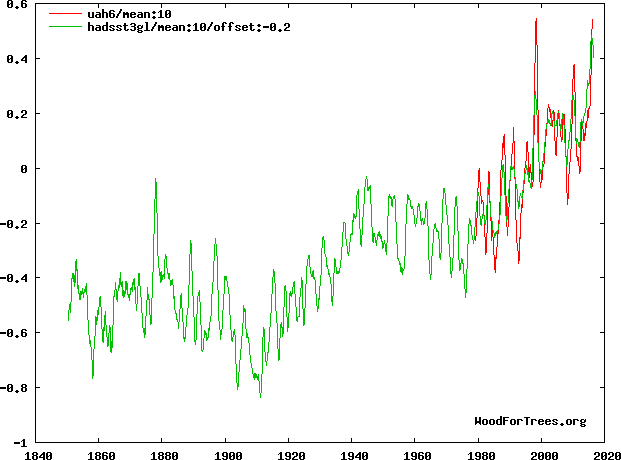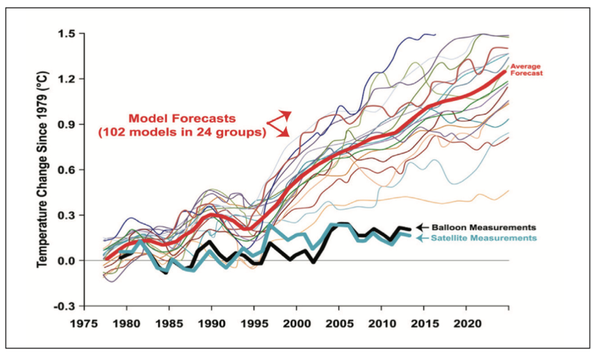Recap: in the last article, I showed that the satellite record, which is our most reliable indication of global temperatures, is most like the sea temperature record and least like the land based record. I had a go at trying to suggest a possible physical cause (other that data manipulation and/or rural heating), but as the aim is to create my own long term temperature series it does suggest a way forward.
Below is a plot of global sea temperatures HADSST3 and UAH6 with a 0.2C offset to UAH6

I think you’ll agree that is a remarkable fit. Which means that my best estimate of what a series like UAH6 would show in the past is HASSST3. So, now rather than relying on Hansen et al 1981 which is using known biased source I can create a long term series from HADSST:
 Not only is HADSST3 a good fit to CET, but having decided that HADSST (which is almost identical to UAH6) is our best proxy for global temperature it is great to find that CET appears to be a better fit to HADSST than Hansen et al 1981. In other words it appears I am quite justified in ditching Hansen altogether.
Not only is HADSST3 a good fit to CET, but having decided that HADSST (which is almost identical to UAH6) is our best proxy for global temperature it is great to find that CET appears to be a better fit to HADSST than Hansen et al 1981. In other words it appears I am quite justified in ditching Hansen altogether.
So, I am now quite confident that this combination now represent the best proxy of global temperature for the last 350 years.
Comment
Why, you may well ask is CET such a good proxy for global temperature. Well, the answer is pretty obvious if you live in the UK had suffer the constant SW winds from the Atlantic: the British temperature is largely determined by the Atlantic and of course that being an ocean temperature is like the total global sea temperature of HADSST3.
I already knew UAH was corroborated by meteorological balloon data as shown in this graphic comparing both to model forecasts.
 And now I see how well HADSST3 correlates with UAH6 and how well CET correlates with both these I am more certain than ever that UAH is our best proxy for current global temperature, that before that HADSST3 (not any land-based measurements) is our best proxy and before that CET is an extremely good proxy.
And now I see how well HADSST3 correlates with UAH6 and how well CET correlates with both these I am more certain than ever that UAH is our best proxy for current global temperature, that before that HADSST3 (not any land-based measurements) is our best proxy and before that CET is an extremely good proxy.
And all these show that nothing at all has changed. Indeed, if anything I am more certain that the cooler temperatures of UAH6 are representative of global temperatures and that there is something seriously wrong with the land based measurements.
Is the current period abnormal?
At this point, it’s worth referring back to an older article: Proof: recent temperature trends are not abnormal. In this article I presented evidence showing the rate of change over various time windows throughout the period as presented below:
 Note: Periods are plotted by average date
Note: Periods are plotted by average date
This proves that there is nothing at all abnormal with recent temperatures. I’d like to just restate that: nothing has changed whatsoever with the rates of change of global temperature over any period you wish to look at.
And now I’ve confirmed that CET is actually a very good proxy because it matches HADSST3 and HADSST3 is almost identical to our best current temperatures in UAH6 I can be even more certain in my conclusion:
Conclusion: There is ABSOLUTELY NO EVIDENCE of any discernible change in global climate caused by rising CO2 or indeed anything else recently. The climate continues changing as it has throughout at least the last 350 years.
Addendum
Yesterday I had a comment from Steve Mosher suggesting issues to do with ice-melting and emissivity. If this was an issue, it would be pretty easy to show graphic with the discrepancy indicating that it is massive where there is ice. Having searched, I note that no such graphics or graphs exist. That speaks volumes, particularly given the massive resources constantly trying to undermine the credible and reliable satellite records. It is quite certain they tried to prove there was a problem and failed even to themselves. As happens so often in the arena of climate – we learn most from the evidence they won’t produce.


IMO “Global Temperature” is as nebulous a concept as “Global Mobile Phone Number”, and about as useful.
I suppose it makes a good living for peddlers of dodgy second-hand temperature databases…
HadSST3 also provides a good understanding of how the recent 2015-2016 GMT results were produced by oceanic fluctuations.
https://rclutz.wordpress.com/2017/01/20/oceans-make-2015-2016-climate/
Yes it’s a bit like asking whether a pizza tastes good, since it is composed of so many different bits – but we all ask such questions and expect some kind of reply.
Interesting!
Pingback: Understanding the Global Temperature III | Scottish Sceptic